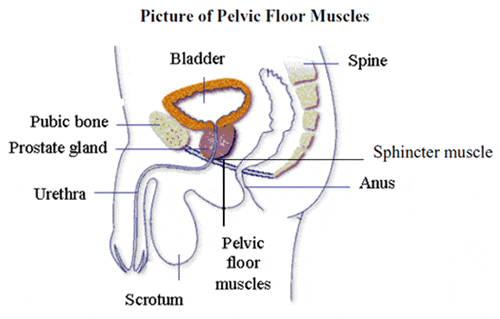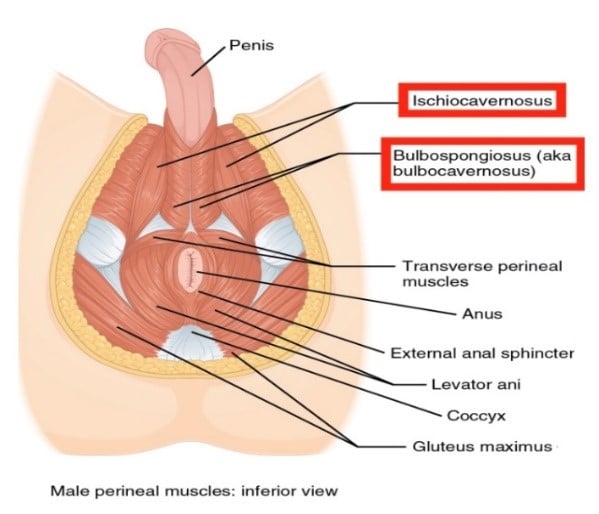The main type of surgery for prostate cancer is a radical prostatectomy.
What is a radical prostatectomy?
A surgical procedure where the prostate gland along with the seminal vesicles (glands that produce some of the fluid in semen) and vas deferens (a duct which carries semen) are removed, then the urethra is reconnected to the bladder.
There are 3 different approaches the urologist can take:
- Open radical prostatectomy
- Laparoscopic radical prostatectomy
- Robotic-assisted radical prostatectomy
Currently, there is no high-level evidence that one technique is better than the other. All three forms of have similar rates of side effects.


Before and after surgery (prostate.org 2020).
Side effects of a prostatectomy
- Erectile dysfunction
- Bladder dysfunction
- Urine leakage/urinary incontinence
- Bowel incontinence
- Poor quality of life
- Pain in groin area
How can exercise help reduce side effects pre/ post surgery?
KEGEL EXERCISES
Kegels are an exercise that help strengthen the pelvic floor muscles, which include the bladder, sphincter muscles and the pelvic floor muscle (pubococcygeus). The urethra (urine tube) and rectum (anus) pass through the pelvic floor muscles. Therefore, the pelvic floor muscles help control urine flow, bowel movement and erections.

How to activate the pelvic floor muscles:
- Ensure you empty your bladder prior to performing these exercises
- Start by lying on your back with knees bent hip width apart and feet flat on the floor
- Place two fingers on each side of your stomach, 2 finger widths inside of your hip bones
- Apply comfortable downward pressure with your fingers deep enough to feel the lift indicating the pelvic floor muscles contracting
Visualisation: Imagine you are stopping the flow of urine or there is a string pulling up from your pubic bone to your head or drawing your penis towards your guts. Squeeze in the muscles around the penis and back passage sucking upwards towards the head deep inside the pelvis
Hold the activation for:
- 5-10secs pre-surgery
- 3-5 seconds 3 weeks post-surgery AFTER CATHETER HAS BEEN REMOVED (usually 7-10days post-surgery date)
- 5-7 seconds 3-5 weeks post-surgery
- 7-10 seconds 5 + weeks post-surgery
- Perform 10-20 repetitions
After each contraction ensure to relax the muscles, it is just as important as the activation to ensure the muscles recover before contracting again. If you are struggling to feel the correct activation try changing your position to seated or standing
NOTE: There are many different methods and cues, so it is important to find the one that helps you activate the pelvic floor muscles most effectively.
How do I know if I am activating the correct muscles?
- You should feel a squeeze/lift of the front and back passages up and inside the pelvis
- Be able to maintain normal breathing throughout all the repetitions
- Buttocks, thighs, and abdominal muscles should be relaxed
- Some tightening and flattening of the lower tummy will occur
- No tensing of the muscles above the belly button should occur
- It is only a small lift movement that should be felt
Performing these internal exercises correctly is important and harmful if not performed correctly, so it is important if you are unsure to seek advice from your urologist, GP, or other health professionals such as an exercise physiologist.
How frequently should I perform my kegel exercises?
Start with 1 time a day then once you are certain you are achieving the correct activation progressively build up to 3-4 times a day, no more than 10 x a day. Start performing Kegel exercises prior to prostate treatment, as it will start the neuromuscular and strengthening process of these muscles.
REMEMBER: the pelvic floor muscles are like any other muscle in the body it takes regular exercise to strengthen them.
When will I see a difference in my incontinence?
You should start noticing less leakage after 4-6 weeks of consistent daily exercise, and an even larger difference after 3 months. However, it is important to keep in mind everyone is different in their healing time.
When will I see a difference in my erectile dysfunction?
Pelvic floor muscles attach to the base of the penis, when they contract, they increase the stiffness and rigidity of the penis and help you keep that rigidity during intercourse. Night time erections can start to occur after about 4 weeks of regular consistent performing kegel exercises, but others it can take up to 3-6 months.

A combination of aerobic and resistance exercise has been proven to be best in reducing the side effects post prostatectomy, however there are considerations that need to be accounted for.
AEROBIC EXERCISE
Walking: at least 30 minutes every day or 150 minutes a week at a moderate intensity (breathing heavily but can still maintain a short conversation). Can be performed with catheter in as tolerated. Only do what you can manage, beginning with 10-minute blocks and progress as you improve is fine.
Consideration…. Cycling: ONLY perform 12 weeks post-surgery to allow the new join between bladder and urethra to heal before being subject to the sustained pressure and trauma from a narrow bike saddle. Start with no more than 30 mins at a time.
STRENGTH EXERCISE
After surgery:
- Two weeks: NO lifting
- 2-6 weeks: light lifting e.g. shopping bags
- 6 weeks onwards: heavy lifting e.g. big suitcase
Once you are cleared by your doctor or healthcare team to start lifting aim for 2-3 sessions of strength a week of major muscle groups, starting with light weights and slowly progressing (i.e. 2-5kg every 10-14days).
PLEASE NOTE: These are guidelines from prostate cancer foundation, but it is important to always consult your doctor or healthcare team to advise you base on your specific case. If you have any concerns, are unsure of how you are performing the kegel exercises or would like to find out more about exercise guidelines speak to your doctor, urologist or your healthcare team.
From someone who has been through it:
“I was diagnosed with prostate cancer in May 2020 and after surgery in July at first it was a bit difficult doing the exercises because I would leak every time I exerted myself but working with my Exercise Physiologist and taking her advice it has been 6 weeks and I am back to where I was prior to my op.
Do the exercises recommended, this advice was given to me by my Exercise Physiologist as well as by a mate of mine who had his prostrate removed 3 years ago.
Set goals for yourself as I have done you will find the results encouraging. My ultimate goal us to get back to practising martial arts and I feel I am well on the way to getting back to the dojo.”
Anonymous Movement Mill Patient
Further information
How can you show your support and get involved?
DONATE or Join the LONG RUN – run, walk or ride 72km. Track your kilometres you complete in the month of September (Prostate Awareness Month).

By Michelle Brown; Accredited Exercise Physiologist
References:
- Prostate.org
- Thelongrun.org.au
- uclahealth.org
- Continence foundation of Australia

